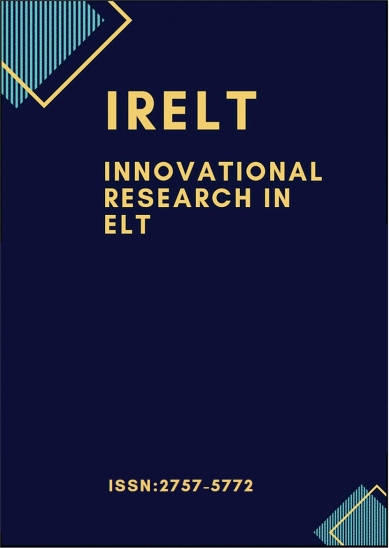Research article | Open Access
Innovational Research in ELT 2020, Vol. 1(1) 21-33
Gender stereotyping: beliefs and practices of Turkish EFL instructors at a non-profit university
pp. 21 - 33 | DOI: https://doi.org/10.29329/irelt.2020.311.3
Publish Date: December 17, 2020 | Single/Total View: 231/993 | Single/Total Download: 292/2.237
Abstract
The study investigates the beliefs of instructors working in a school of foreign languages of a non-profit university in Turkey towards gender stereotyping, how often they encounter gender-biased behaviours among students and their perception of gender stereotypical practices in the classroom. Data from a questionnaire of 54 teachers were analysed through SPSS. The results reveal that the majority of the participants disagree with stereotyped beliefs. Almost all of them encounter gender-biased behaviours in class and they put gender equitable language into practice.
Keywords: EFL instructors, gender stereotyping, instructor beliefs on gender stereotyping
APA 7th edition
Arslan, G. (2020). Gender stereotyping: beliefs and practices of Turkish EFL instructors at a non-profit university. Innovational Research in ELT, 1(1), 21-33. https://doi.org/10.29329/irelt.2020.311.3
Harvard
Arslan, G. (2020). Gender stereotyping: beliefs and practices of Turkish EFL instructors at a non-profit university. Innovational Research in ELT, 1(1), pp. 21-33.
Chicago 16th edition
Arslan, Gizem (2020). "Gender stereotyping: beliefs and practices of Turkish EFL instructors at a non-profit university". Innovational Research in ELT 1 (1):21-33. https://doi.org/10.29329/irelt.2020.311.3
Aliakbari, M. &Faraji, E. (2011). Basic Principles of Critical Pedagogy. 2nd International Conference on Humanities, Historical and Social Sciences IPEDR, 17, 78-85.
Aslan, O. (2009). The role of gender and language learning strategies in learning English (Unpublished Master’s thesis). METU, Ankara.
Aydınoğlu, N. (2014). Gender in English language teaching coursebooks. Procedia-Social and Behavioral Sciences, 158, 233-239.
Brown, H. D. (2002). English language teaching in the “post-method” era: Toward better diagnosis, treatment, and assessment. Methodology in language teaching: An anthology of current practice, 9-18.
Commeyras, M. (1997). Educators' Stances toward Gender Issues in Literacy.Annual Meeting of the American Educational Research Association. Chicago, IL: Illinois.
Cüceloğlu, D. (1993). İnsan ve davranışı. İstanbul: Remzi Kitabevi.
Diekman, A. B., &Eagly, A. H. (2000). Stereotypes as dynamic constructs: Women and men of the past, present, and future. Personality and social psychology bulletin, 26(10), 1171-1188.
Dökmen, Z. Y. (1999). Bem Cinsiyet Rolü Envanteri kadinsilik ve erkeksilik ölçekleri Türkçe formunun psikometrik özellikleri. Kriz Dergisi, 7(1), 27-40.
Fung, A., &Ma, E. (2000). Formal vs. informal use of television and gender-rote stereotyping in Hong Kong. Sex Roles, 42, 57-81.
García, A. M., &Slesaransky-Poe, G. (2010). The heteronormative classroom: Questioning and liberating practices. The Teacher Educator, 45(4), 244-256.
Gray, C., &Leith, H. (2004). Perpetuating gender stereotypes in the classroom: A teacher perspective. Educational Studies, 30(1), 3-17.
Hall, C. S., Lindzey, G., &Campbell, J. B. (1997). Theories of personality. (4th ed.). John Wiley & Sons Inc., New York: Wiley.
Ifegbesan, A. (2010). Gender-stereotypes belief and practices in the classroom: The Nigerian post-primary school teachers. Global Journal of Human Social Science, 10(4), 29-38.
Jones, S. M., &Dindia, K. (2004). A meta-analytic perspective on sex equity in the classroom. Review of educational research, 74(4), 443-471.
Jost, J. T., & Kay, A. C. (2005). Exposure to benevolent sexism and complementary gender stereotypes: consequences for specific and diffuse forms of system justification. Journal of personality and social psychology, 88(3), 498.
Kağıtçıbaşı, Ç. (1982). The Changing Value of Children in Turkey. Current Studies on the Value of Children (No. 60-E). Honolulu: East West Population Institute
Publication. No. 60-E.
Kağıtçıbaşı, Ç., &Sunar, D. (1992). Family and socialization in Turkey. Parent-child relations in diverse cultural settings: Socialization for instrumental competency, 5, 75-88.
Kızılaslan, I. (2010). Student teachers’ perceptions of gendered texts in English language textbooks. Procedia-Social and Behavioral Sciences, 2(2), 3528-3531.
López-Sáez, M., Morales, J. F., &Lisbona, A. (2008). Evolution of gender stereotypes in Spain: Traits and roles. The Spanish Journal of Psychology, 11(2), 609-617.
Lorber, J. (2001). Gender inequality (4thed.). Los Angeles, CA: Roxbury.
Marshall, S. P., & Smith, J. D. (1987). Sex differences in learning mathematics: A longitudinal study with item and error analyses. Journal of Educational Psychology, 79(4), 372.
Martin, C. L., & Halverson Jr, C. F. (1981). A schematic processing model of sex typing and stereotyping in children. Child development, 1119-1134.
Ooiwa-Yoshizawa, A. (2018). Implications of EFL Critical Pedagogy: Theory, Practice and Possibility. Learning, 19, 245-253.
Ozer, D., Karatas, Z., &Ergun, O. R. (2019). Analysis of Gender Roles in Primary School (1st to 4th Grade) Turkish Textbooks. Eurasian Journal of Educational Research, 79, 1-20.
Özkan, T., &Lajunen, T. (2005). Masculinity, femininity, and the Bem sex role inventory in Turkey. Sex Roles, 52(1-2), 103-110.
Öztürk, G., &Gürbüz, N. (2013). The impact of gender on foreign language speaking anxiety and motivation. Procedia-Social and Behavioral Sciences, 70, 654-665.
Schmenk, B. (2004). Language learning: A feminine domain? The role of stereotyping in constructing gendered learner identities. TESOL quarterly, 38(3), 514-524.
Söğüt, S. (2018). Gender representations in high school EFL coursebooks: An investigation of job and adjective attributions. Abant İzzet Baysal Üniversitesi Eğitim Fakültesi Dergisi, 18(3), 1722-1737.
Sunar, D. (1982). Female stereotypes in the U.S. and Turkey:An application of functional theory to perceptions in powerrelations. Journal of Cross-Cultural Psychology, 13, 445–460.
Şeker, M., &Dinçer, A. (2014). An Analysis of Gender Stereotyping in English Teaching Course Books. Çukurova University Faculty of Education Journal, 43(1).
Tatar, M., &Emmanuel, G. (2001). Teachers' perceptions of their students' gender roles. The Journal of Educational Research, 94(4), 215-224.
Tiedemann, J. (2000). Parents' gender stereotypes and teachers' beliefs as predictors of children's concept of their mathematical ability in elementary school. Journal of Educational psychology, 92(1), 144.
UNESCO. n.d. Retrieved from https://en.unesco.org/themes/education/sdgs/material/05
West, C., &Zimmerman, D. H. (1987). Doing gender. Gender & society, 1(2), 125-151.
Younger, M., &Warrington, M. (1996). Differential achievement of girls and boys at GCSE: Some observations from the perspective of one school. British journal of Sociology of Education, 17(3), 299-313.
